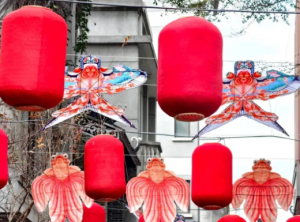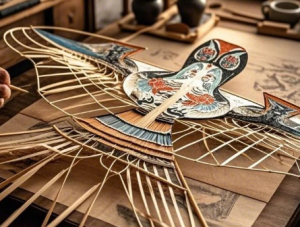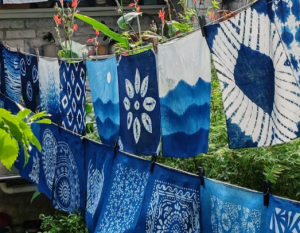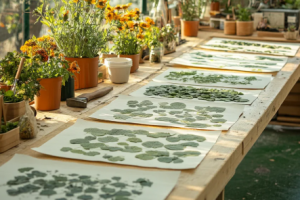In the vast sky, a kite dances on the breeze, tethered by a single thread—a sight that has captivated the Chinese imagination for millennia. More than just a playful object, the kite is a vibrant symbol of Chinese folklore, craftsmanship, and philosophical thought, embodying the timeless dream of harmony between humanity and nature.

Soaring Through Time: The Historical Journey of Kites
The origins of kites in China trace back over two millennia, with their invention deeply rooted in practical and spiritual beginnings.
-
Early Innovations (Warring States Period, 475–221 BCE)
The earliest prototypes of kites were not made for recreation. They are believed to have evolved from primitive tools like large wooden or bamboo constructs known as muyuan (wooden kites). Legend credits the philosopher Mozi with designing a wooden bird that could fly for three days, while the renowned carpenter Lu Ban was said to have crafted bamboo kites for military reconnaissance. -
From Military Tool to Cultural Icon (Tang and Song Dynasties)
With the invention of paper, kites became lighter and more accessible, transitioning from military use to a popular pastime. By the Tang Dynasty, kite-flying had become a widespread social and artistic activity. The Song Dynasty saw kites fully integrated into folk culture, flown for enjoyment and during seasonal festivals. It was also during this period that kites began to be exported, spreading first to Korea and Japan, and later to the rest of the world. -
The Name ‘Fengzheng’ (Northern and Southern Dynasties)
The Chinese word for kite, Fengzheng (风筝), literally meaning “wind zither,” originated in the 5th century when people began attaching bamboo whistles or strings to kites. These would produce a humming or zither-like sound in the wind, making the kite not just a visual spectacle but an aerial musical instrument.
The Art of Flight: Materials and Crafting Techniques
The creation of a traditional Chinese kite is a meticulous art form, a perfect synthesis of craftsmanship, painting, and aerodynamics. The process is traditionally summarized in four essential steps:
-
Selecting and Framing (扎, Zha)
The artisan selects flexible yet sturdy bamboo, often from the Mao bamboo species. The bamboo is split, shaved, and bent over a flame to form a light and balanced skeleton. The frame must be symmetrical and precisely calibrated to ensure stable flight. -
Pasting and Covering (糊, Hu)
High-quality silk or paper, such as Xuan paper, is carefully glued over the bamboo frame. The covering must be taut and smooth, without wrinkles, to catch the wind effectively. The choice of material greatly influences the kite’s weight, durability, and aesthetic. -
Painting and Embellishing (绘, Hui)
This is where the kite truly comes to life. Artisans paint vibrant designs directly onto the covered surface. Themes are deeply symbolic, drawn from Chinese mythology, folklore, and nature. Common motifs include:-
The Centipede (蜈蚣): Representing power and warding off evil spirits.
-
The Swallow (燕子): A symbol of spring and good fortune.
-
Carp (鲤鱼): Representing perseverance and success.
-
Dragons and Phoenixes: Symbols of imperial power and harmony.
-
-
Rigging and Flying (放, Fang)
The final step is attaching the bridle and tethering line. The attachment points must be calculated with precision to achieve the correct flying angle. A well-made kite will soar steadily, responding gracefully to tugs on its line.
Cultural Threads: The Symbolism of Kites
In Chinese culture, kites have always been more than toys. They are imbued with rich symbolic meaning. Flying a kite was seen as a way to send one’s troubles and misfortunes heavenward. It was also an activity that promoted health and vitality.
Furthermore, kites were integral to festivals, most notably the Qingming Festival. The act of flying a kite and then cutting the line was a symbolic gesture of letting go of the past and inviting good health for the coming year.
A New Breeze: Modern Revival and Global Influence
The 20th century saw a decline in traditional kite-making, but recent decades have witnessed a powerful revival, fueled by the intangible cultural heritage movement.
-
UNESCO Recognition
Kite-making traditions from regions like Weifang (Shandong), Beijing, and Tianjin have been inscribed on China’s National Intangible Cultural Heritage list, with Weifang celebrated as the “Kite Capital of the World.” -
The Weifang International Kite Festival
Since 1984, this annual event has drawn kite enthusiasts from across the globe, transforming into a spectacular carnival of color and creativity. It has been instrumental in preserving traditional styles while inspiring modern innovations. -
Contemporary Art and Design
Today’s kite artists are pushing boundaries, creating intricate giant kites and minimalist modern designs. They experiment with new materials like synthetic fabrics and carbon fiber, yet the soul of the craft—the handmade bamboo frame and the symbolic painting—remains revered.
An Enduring Legacy
From a military instrument to a celestial canvas, the Chinese kite has journeyed through history without losing its magic. It is a timeless bridge between the earthly and the divine, a symbol of human aspiration and artistic expression. As each new kite takes flight, it carries with it the dreams of ancient philosophers and the skilled hands of master artisans, ensuring that this delicate thread to the past will continue to dance in the skies for generations to come.
猜你喜欢
发表评论
电子邮件地址不会被公开。 必填项已用*标注






